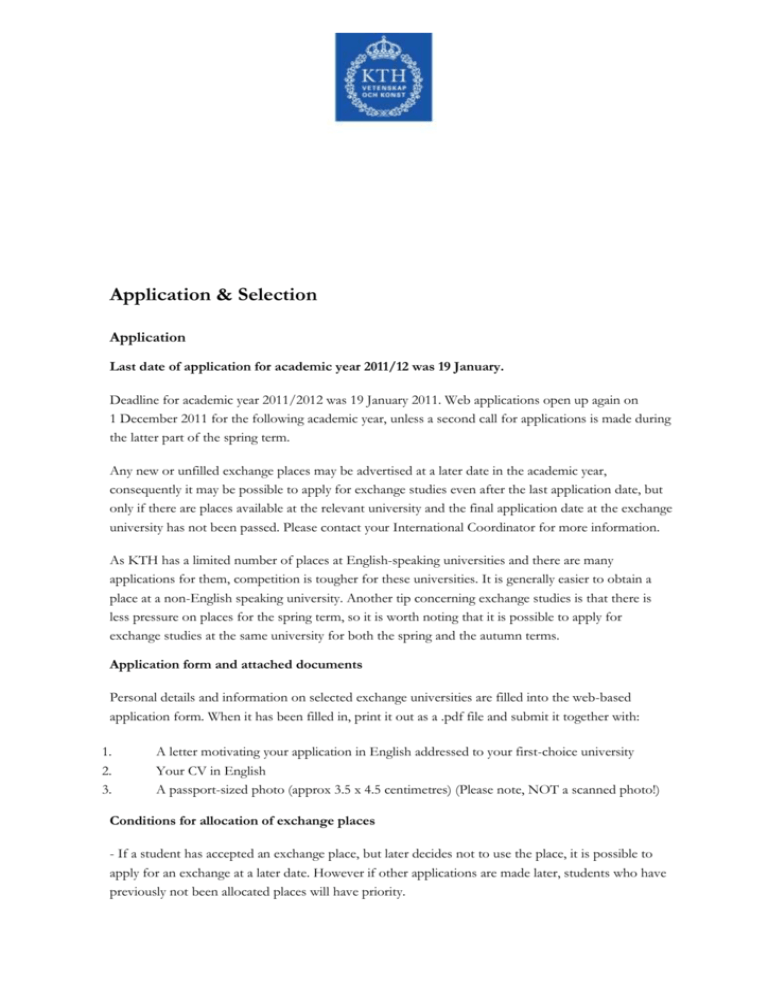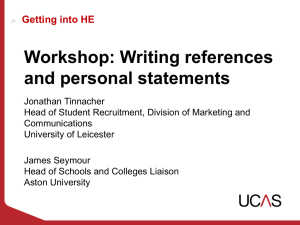brevmall
advertisement

Application & Selection Application Last date of application for academic year 2011/12 was 19 January. Deadline for academic year 2011/2012 was 19 January 2011. Web applications open up again on 1 December 2011 for the following academic year, unless a second call for applications is made during the latter part of the spring term. Any new or unfilled exchange places may be advertised at a later date in the academic year, consequently it may be possible to apply for exchange studies even after the last application date, but only if there are places available at the relevant university and the final application date at the exchange university has not been passed. Please contact your International Coordinator for more information. As KTH has a limited number of places at English-speaking universities and there are many applications for them, competition is tougher for these universities. It is generally easier to obtain a place at a non-English speaking university. Another tip concerning exchange studies is that there is less pressure on places for the spring term, so it is worth noting that it is possible to apply for exchange studies at the same university for both the spring and the autumn terms. Application form and attached documents Personal details and information on selected exchange universities are filled into the web-based application form. When it has been filled in, print it out as a .pdf file and submit it together with: 1. 2. 3. A letter motivating your application in English addressed to your first-choice university Your CV in English A passport-sized photo (approx 3.5 x 4.5 centimetres) (Please note, NOT a scanned photo!) Conditions for allocation of exchange places - If a student has accepted an exchange place, but later decides not to use the place, it is possible to apply for an exchange at a later date. However if other applications are made later, students who have previously not been allocated places will have priority. - If a student has been on an exchange it is possible to apply for more exchange studies. However students who have previously not been allocated places will have priority. Selection If there is competition for places at a certain university, a selection will be made based on average grades at KTH. The formula used is as follows: Total (Grades x (number of possible, compulsory credits))/[Total (number of possible, compulsory credits)] + 0.2 (if the student has acted as a mentor for an exchange student coming to KTH) In order to be able to compare the new grade scale (A-E) and the previous system (3-5), the new letter grades are translated to figures according to the following model: A=5 B=4.5 C=4 D=3.5 E=3 With the exception of a few universities (please refer to heading "Universities with admission requirements" below) there is no established limit for the average grade level necessary to be able to study abroad. Rules for selection Grades in figures (3,4,5) will be used on all courses that began before 1 July 2007. Study qualifications are based on the credits accrued from courses and sub-courses that have been completed by 7 January at the latest (Period 2). Consequently results from exam retakes in January cannot be included in the comparison credit amount. For students going out to another university from Year 3 and Year 4, only the compulsory courses in the previous year are counted. If the syllabus of the previous year's courses amount to less that 30 higher education credits for compulsory courses per term, elective courses are included up to the total of 30 higher education credits. For students going out to another university from Year 5, the compulsory courses in the basic block of courses plus courses in the specialization selected are counted together. If the syllabus amounts to less that 30 higher education credits for compulsory courses, elective courses are included up to the total of 30 higher education credits. Completed courses that only issue the grade "pass" are not included in the calculation of comparison points. If a partial grade of “pass” is given for a non-completed course, the grade is counted as a 3. If a grade is assigned in a partial course, “partial grade X points” is stated. Error! Reference source not found. Error! Reference source not found. 2 (3) When including credits from other universities, grades from these universities are only counted if studies have been undertaken in a Master of Science in Engineering programme in Sweden. In all other cases the grades are not included, comparison points will be based on studies at KTH only. International activities within KTH give 0.2 extra points for the comparison points. International activities are defined as students actively participating in the Student Union or Student Union Section activities for reception of incoming exchange students/master students. In the Master of Science in Engineering/Education Degree Programme, students study compulsory courses at the Stockholm University Teacher Education Department. This department awards the grades Pass and Pass with Distinction. These grades are awarded the figures Pass = 3, Pass with Distinction = 4.5. The average grade level is calculated to one decimal. If scores are equal, the suitability of the student for exchange studies is assessed based on his/her university profile and study objectives. Universities with admission requirements Some universities in China, Japan and India are specific elite universities where the study tempo is high. In order to be able to succeed at these universities, it is necessary that exchange students have earned extremely high grades. These universities require a minimum grade point average of 4.0 in order to be admitted as an exchange student. Indian Institute of Technology Indian Institute of Science University of Tokyo Kyoto University Waseda University Keio University Tsinghua University Peking University Fudan University Error! Reference source not found. Error! Reference source not found. 3 (3)






